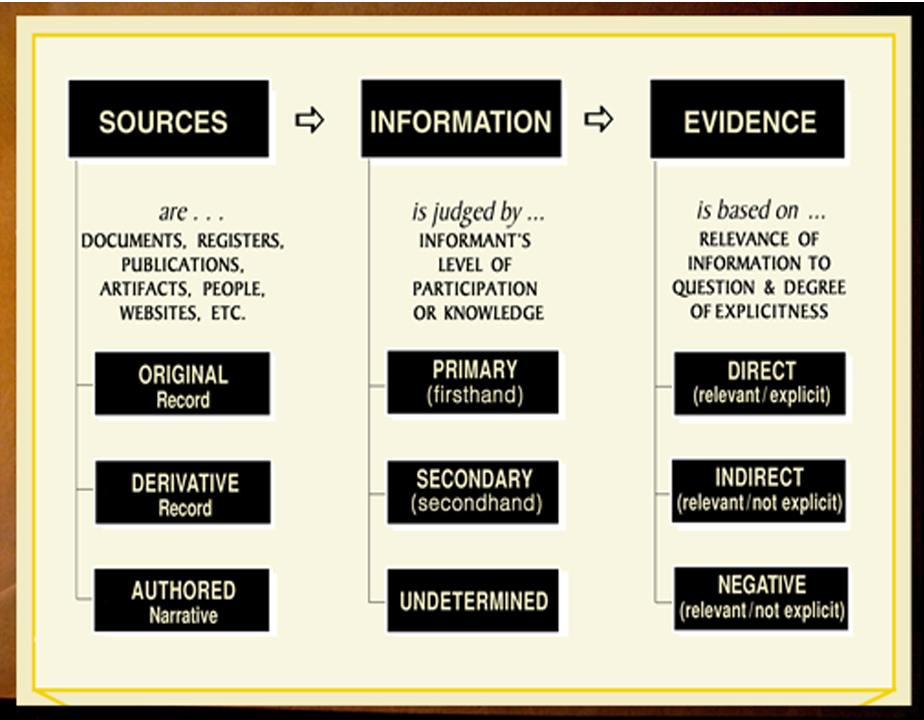
Sources give us information, from which we identify evidence. All undergo the evaluation process to produce proof.
Users of Evidence Explained well know this mantra. The Evidence Analysis Process Map lays it out in a tidy graphic on EE’s flyleaf. Fig. 1, in this lesson, gives the newly expanded version.1
So how does this mantra fit into our daily work? Is it just an esoteric theory for eggheads? Is it jargon we can handily throw around if we want to impress teachers, students, or clients? Is it a formula we follow if we want certification in a research field? Or an easy way to eliminate all the angst involved in evidence analysis?
EE hopes you answered: None of the above. Using the Evidence Analysis Process Map is akin to using the structure of our native language. As youth, we learned the parts of speech that serve as a framework for communication: nouns, verbs, adverbs, adjectives, prepositions, conjunctions, etc. Once we learned those labels, we did not start hanging them on every word we uttered. Yet the extent to which we understand those basic parts of speech will determine how successfully we communicate.
So it is with historical research and analysis. When we report our findings and conclusions, we do not artificially peg labels onto every “fact” or assertion we make. Nonetheless, the extent to which we understand the language and structure of evidence analysis will determine the success of our research.
QuickLesson 17 will give you that foundation.
THREE ANALYTICAL ELEMENTS—SOURCES, INFORMATION & EVIDENCE
Sources
This analytical element comes in many formats. Sources may be documents or books, artifacts or websites, databases or people, but they will still fall into one of three basic classes:
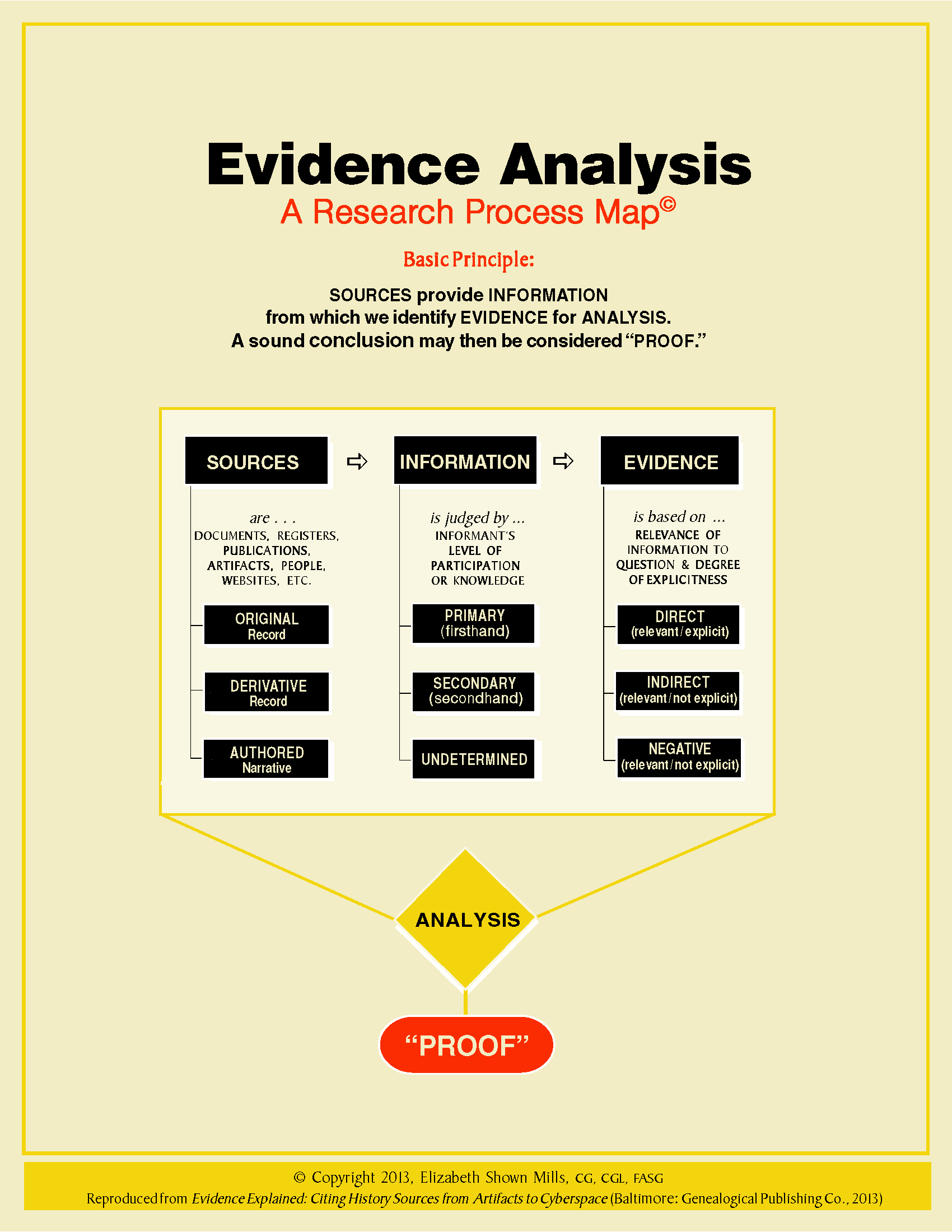
- Original Records: documents that represent the origin of a tangible source—the first time it was written or the first recorded utterance. In our digital era, the concept of “original record” also extends to high-quality images of those originals.
- Derivative Records: materials that offer alternate versions of the original—typically transcripts, translations, abstracts, extracts, nutshells, indexes, and database entries. The best derivatives will preserve all the essential details of the original. Still, errors are frequent.
- Authored Narratives: hybrid works. Authors of historical narratives will study many sources and synthesize findings. From that study, they reach conclusions and then develop a totally new piece of writing. Because the core information comes from other materials, much of an authored work is derivative. However, an author's conclusions and narrative will (or should) form a new, original, creation.2
Information
The “facts” that our sources provide also come in three basic classes:
- Primary information: that is, information based on firsthand knowledge. Primary informants tell us about events or circumstances they personally participated in or witnessed. They might provide that information at or about the time the event occurred or at a later date. A time lapse might affect the quality of the recollection, but it does not alter the primary nature of the information.
- Secondary information: that is, information based on secondhand knowledge. Sources that repeat hearsay, tradition, or lore do not speak from personal knowledge or personal involvement. They merely pass on what others say.
- Undetermined or unknown involvement. Many sources—most census records, for example—do not provide sufficient information to identify an informant or discern whether that person spoke from firsthand or secondhand knowledge. Without that identification, the quality of our information remains undetermined.
Evidence
Evidence is our interpretation of information that we consider relevant to a particular research question. It also exists in three basic classes.
- Direct Evidence: information that obviously addresses the question in one way or another. It may not give us as complete an answer as we would like. (Realistically, evidence seldom tells us everything we want to know about an issue. If it did, it would still be suspect!) The evidence may require us to make a calculation, a correlation, or a conversion of some type; but if it in some way addresses issues involved in our research question, it is direct evidence.
- Indirect Evidence: information that does not directly address our question, although our experience suggests a way to use the information to discover direct evidence or to help build a case. Indirect evidence is seldom obvious and often missed.
- Negative Evidence: Conclusions or implications that can be drawn from the absence of a situation that should exist given the circumstances. Caution: negative evidence is not the same as negative findings. Merely not finding what we hope to find is a routine matter in historical research and one that thoroughness often resolves. Negative evidence, on the other hand, remains negative evidence no matter how much more we find. Negative evidence requires us to understand and consider the implications of what should have occurred under a specific set of circumstances—as with Sherlock Holmes’s famous observation about ‘the sound of the dog not barking’ amid a burglary.
The Evaluation Process
This process—the analysis of the source, its information, and the evidence we draw from it—is only the first step toward a conclusion. It is a step we repeat over and again, as research progresses. Conclusions, on the other hand, must be based on the whole body of evidence that we assemble. In the evaluation stage, which we should also repeat each time we make new findings, we weigh
- the quality of each source against the other;
- the credibility of each piece of information against the other; and
- the strength of each piece of evidence against the other.
We correlate details. We compare and contrast them in a search for patterns, dissimilarities, or conflicts that could strengthen or weaken a conclusion. If we have multiple pieces of evidence pointing to a conclusion, we consider whether each piece of underlying information is independently created—or whether all might be tracked back to a common source. It is also at this point, if we are genealogists, that we apply the Genealogical Proof Standard3 to measure the strength of any hypothesis we might be forming.
THEORY v. PRACTICE
Whether we understand the parts of a theory is tested by applying that theory to our everyday work. Let’s look at an actual research problem and see how the structure of the Evidence Analysis Process Map can help us interpret the strength of our evidence.
(CASE AT POINT)
Egyptian Settlers in Colonial America?
Item 1:
On 19 April 1851, a newspaper editor in Alexandria, Louisiana, published a curious bit of filler:
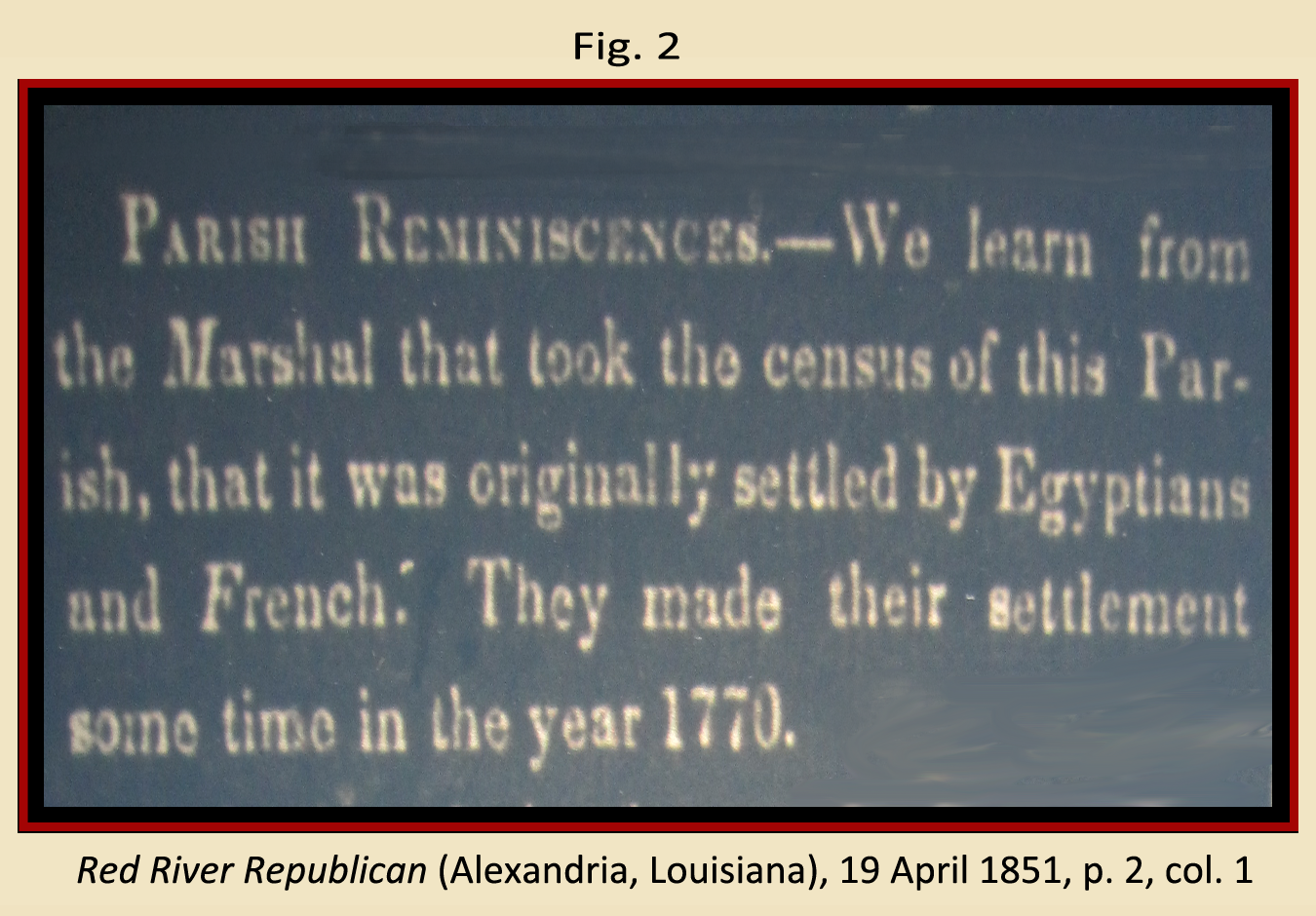
“We learn from the Marshall that took the census of the Parish, that it was originally settled by Egyptians and French. They made their settlement some time in the year 1770.”4
For a city named Alexandria to claim founding by Egyptians is a neat tale, but all historical researchers know how often this kind of lore withers away under the historical microscope. The discovery of a stray Egyptian sailor in New Orleans, or any other colonial American seaport, would hardly raise an eyebrow. The suggestion that a group of Egyptians carved out an agricultural settlement in the interior of the colony begs disbelief. So let’s pose a research question:

Using the Evidence Analysis Process Map, how would we classify the three analytical elements in the factoid published by the newspaper editor?
ANALYSIS:
- Source: Original. It represents the first time that specific assertion made its way into print. (Of course, when we transcribed it above, we created a derivative source. Even before this, when we integrated it into a broader study of ethnic assimilation and marginalization, we created an authored narrative.5 We are, in fact, creating another authored narrative with this QuickLesson—a narrative amid which we intersperse both original images and derivative abstracts. As you can see by comparison, even though we have used some of the same information and records in both narratives, the two narratives are distinctly different and "original" works.)
- Information: Secondary. The newspaper’s account is hearsay, at least a fourth-hand account. The editor tells us what the census marshal told him. The marshal would have heard it from an unidentified parish resident, who almost certainly would not have firsthand knowledge of a 1770 settlement.
- Evidence: Direct. The newspaper account plainly asserts an answer to our question. Of course, this does not mean that some of the first settlers were Egyptian. It only means that this source made that claim.
Item 2:
A month after this newspaper item was published, a senior citizen in the parish was deposed before a local justice of the peace. He was specifically questioned about the original owner of a tract of land in his neighborhood. In that deposition (see Fig. 3), Bret Lacour swore that he had been in the parish since “1803 or 1804,” living in the same settlement. There he had known the man “Mauritaurus” (José Maríe Torres), about whom he also said:
“The wife of Mauritaurus was an Indian woman. her father was an Indian—her mother was called Babé and was what is called an Egyptian.”6
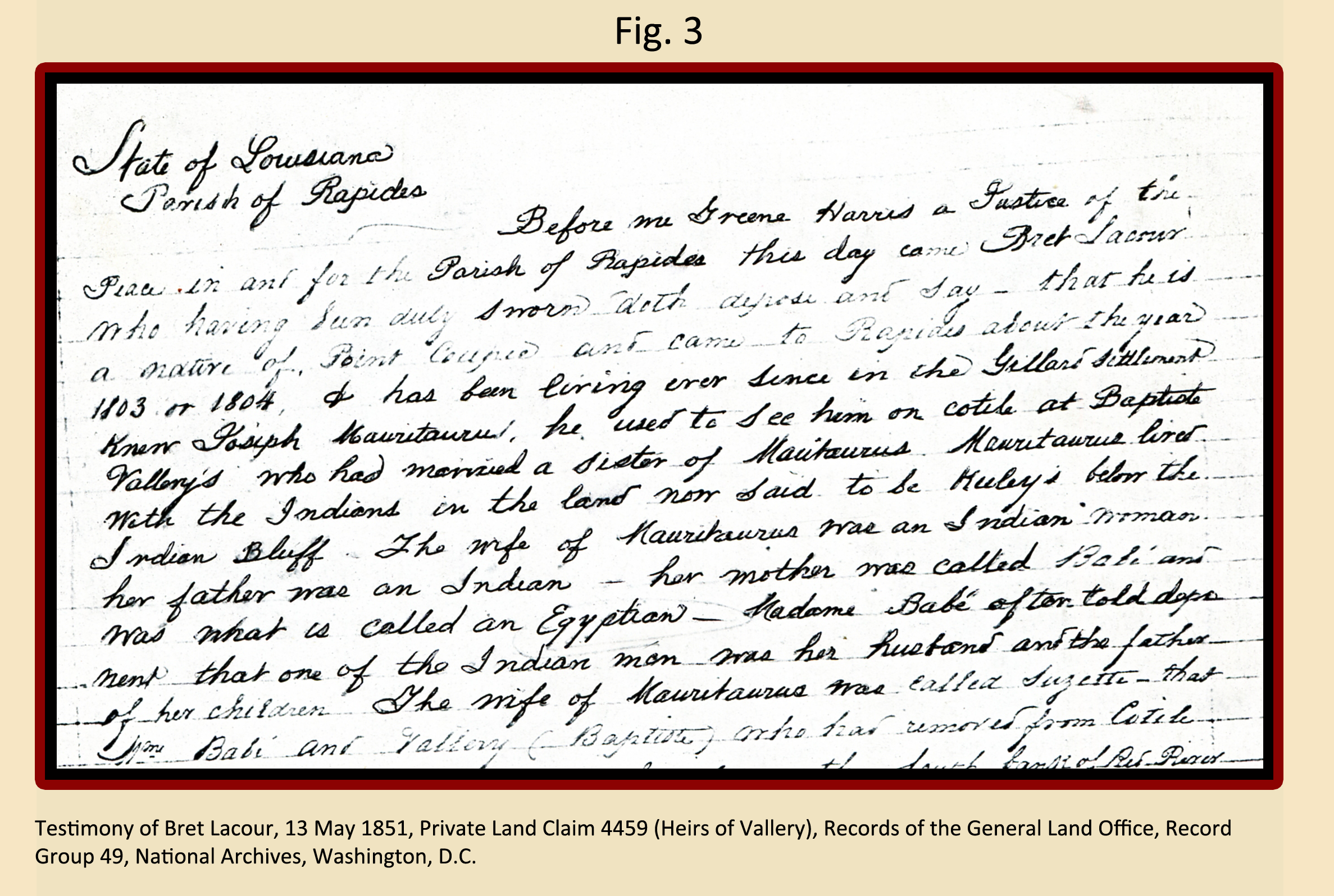
ANALYSIS:
- Source: Original—or duplicate original.7 The document seems original but, considering its provenance (a claim filed with the U.S. Land Office) and knowing the creation process for these claims, it is likely that multiple “originals” were made: one to be kept by the official who drafted the document, possibly one to be kept by the deponent, and one prepared for submission to land-office officials.
- Information: Primary. Lacour is speaking from firsthand knowledge of the people he is discussing. This, of course, is not to say that the woman named Babé actually was an Egyptian—only that she was known to Lacour and the community as someone “called an Egyptian.”
- Evidence: Direct. Lacour makes an outright statement that, rightly or wrongly, supplies an answer to our research question.
Independent corroboration? At this point, we have two different documents stating that one or more early settlers of Rapides was “Egyptian.” Can we now say that one corroborates the other? No. The informant on the May 1851 deposition could have been the same person who gave that historical tidbit to the 1850 census taker—or not. Because we do not know the identity of one of the informants, we cannot treat the two records as independently created sources.
Item 3
The first census of the Louisiana outpost of Rapides was taken 1 February 1773. A published transcription of the French-language document (see Fig. 4) lists eight families8 For the seventh family, you will notice, the formatting of the family data is somewhat different. It carries an introductory word that appears to be a label. Translated into English, the household data itself tells us the following:
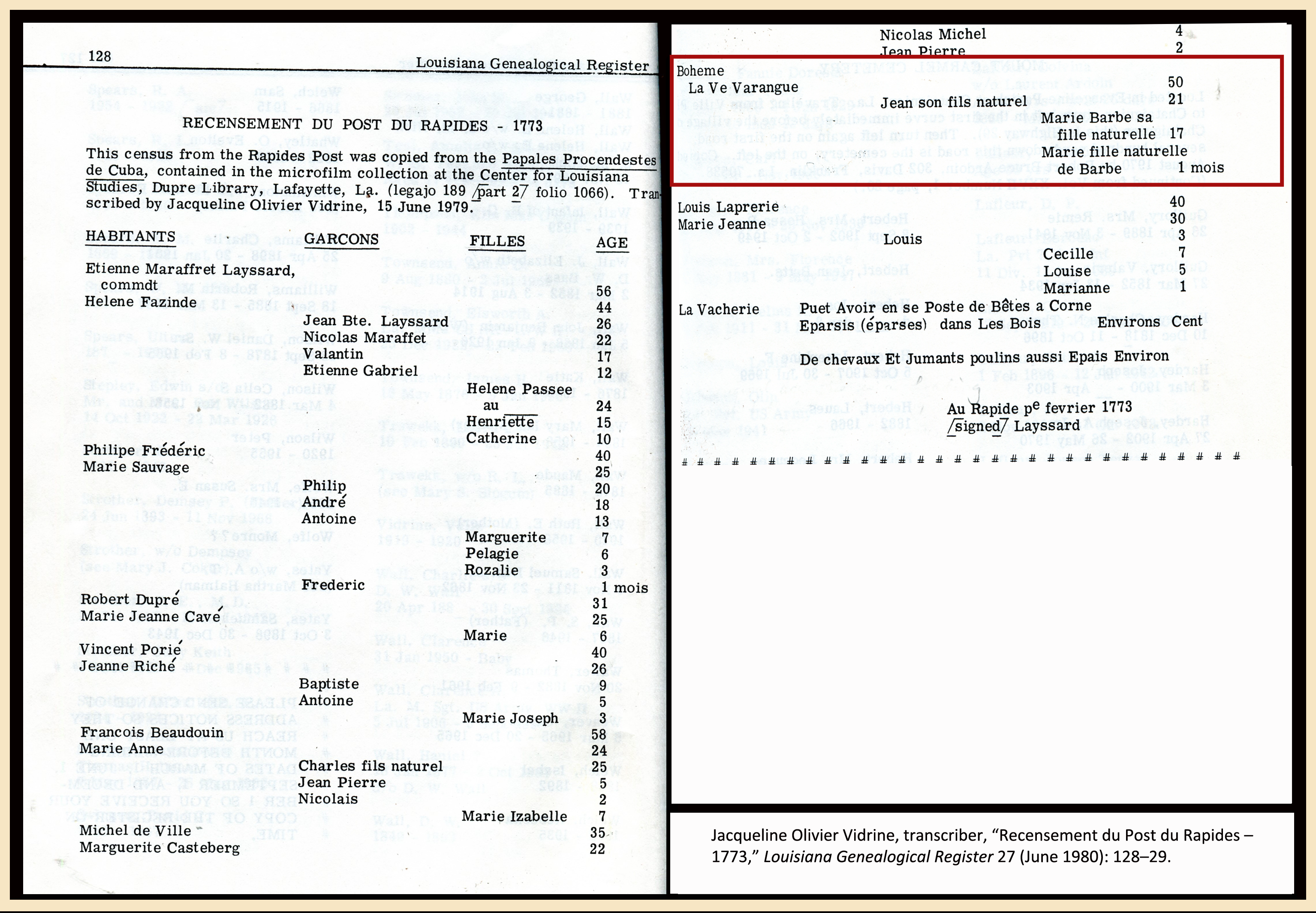
The introductory word Boheme (more correctly: bohème) can be rendered in English in multiple ways. Conventionally, when historians of colonial Louisiana have encountered it in original records, they have interpreted it as “vagabond.” It also can be translated as “Gypsy.”
ANALYSIS:
- Source: Derivative. It is a transcription from the French, which could have any number of transcription errors, even though the transcriber was a highly respected independent researcher of Creole history.
- Information: Undetermined. We know the identity of the census taker. It was the post commandant, who would have identified habitans from his personal knowledge of the eight families at the post. However, we do not know the identity of the family member or neighbor who would have given data (such as ages) that the commandant would not know.
- Evidence: Direct—perhaps. If the word “Bohème” is meant to be an ethnic label rather than a description of lifestyle, then it directly addresses our research question. It also presents an ethnic alternative. The culture commonly called Gypsy is one that was frequently called “Egyptian” in early European accounts.
As is often the case, the original census proved more informative. It cannot be reproduced here, but several points are clear on the document. Significantly, the word Bohème is used as a label for both of the last two families: The Widow Varangue’s household and the “Laprerie” household. Ongoing research would explain why: Mme. Louis La Prairie was the daughter of the Widow Varangue and, as shown in “Assimilation,” Louis La Prairie also shared their ethnic origin.9
Independent corroboration? Yes. The two assertions of the 1850s should not derive from the 1773 census. That document had been sent to the governor and on to Seville; it was not maintained locally. Also, by correlating the 1773 census with the "community knowledge" of the 1850s, we see at least two parallels between the bohème household of 1773 and the later accounts of the “Egyptian” woman Babé:
- Babé, used in the 1851 account, was the common nickname for the French saint name carried by the young woman of the bohème household, Barbe.
- Immediately following the Varangue and “Laprerie” households on the original copy of the 1773 census was an enumeration of the Apalache Indian village. Lacour's full deposition, shown in the link at Fig. 4, placed Babé's family amid the Apalache tribe.
Further research would yield ample evidence that the two women were the same. “Marie Barbe” of this census was indeed Babé. More completely, she was Marie Barbe Josephe Marsant alias Castel and Varangue, wife of the Apalache Indian named Salmon. Her mother, the widow Varangue on this census, was née Cécile Christophe—an exceptionally unconventional woman who had surfaced thirty years earlier as the wayward teenaged bride of a middle-aged Indian trader named Pierre François Castel. Secondly, Cécile had married a Spanish boat caulker named Joseph Sarde dit Barranco. That last husband’s dit (nickname) was rendered phonetically in French as Varangue.10
Thorough research in colonial records yielded dozens of additional documents on both the mother and the daughter. Those records firmly establish Cécile’s ethnic roots as Romani. Her own mother had been one of several 1720 deportees from France who appear variously in Louisiana records as bohème, gitano and (in English) Gypsy and Egyptian.11
The 1773 mother and daughter, Cécile and Babé, also provide us with instructive examples of both negative and indirect evidence.
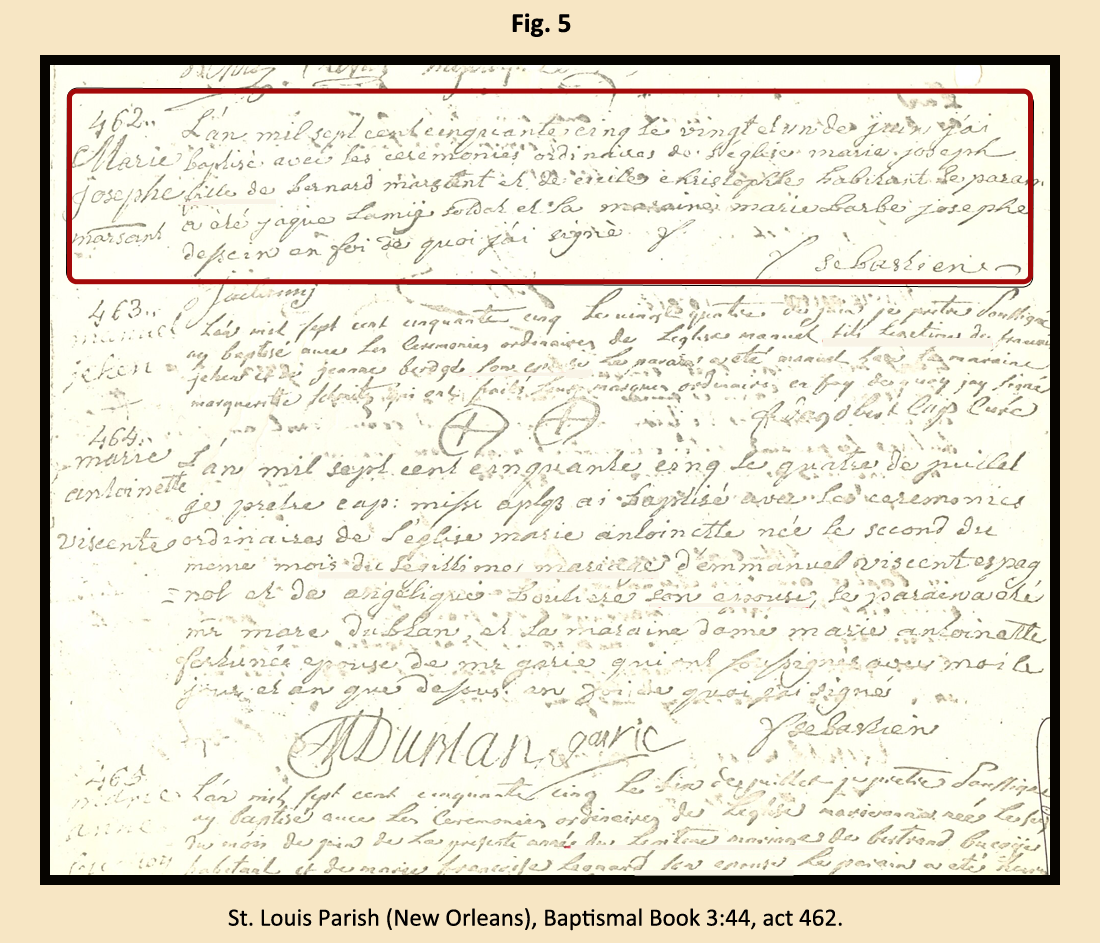
Negative Evidence
Babé was baptized at New Orleans on 21 June 1755. As typical in her time and place, she was named by and for her godmother, Marie Barbe Josephe Desseine. Her baptismal record (see Fig. 5) provides negative evidence about the relationship of her parents. In translation:
Marie Josephe Marsant
The year one thousand seven hundred and fifty five, the twenty-first of June, I have baptized with the ordinary ceremonies of the church, Marie Joseph, daughter of Bernard Marsant and of Cecile Christophle, habitant. The godfather has been Jacques Lamÿ and the godmother Marie Barbe Josephe Dessein, in faith of which I have signed. Father Sebastien.12
As with the dog that had remained silent amid the burglary Sherlock Holmes investigated, this document remains silent on a point critical to the reconstruction of any family unit. The linked Fig. 5 intentionally presents multiple baptismal entries so that you may compare the structure of the records. Even if you do not read French, you should be able to pick out the following points:
- Manuel Jehen ... fils [son] Legitime of ....
- Marie Antoinette Visente ... née [born] ... du Legittime mariage ...
- Marie Anne Bucoÿe ... née ... du Legitime mariage ...
Our negative evidence: The word “legitimate” is conspicuously absent from the baptismal act for Cécile’s daughter by Bernard Marsant. By custom and canon, if the child’s parents were officially married (which, in colonial Louisiana, meant a Catholic marriage), then the sacramental record of the child’s baptism should call the child legitimate.
The absence of that word in the baptismal record creates negative evidence. As such, it does not “prove” that the parents were not married. After all, Father Sebastien could have been distracted while creating the record and merely made an error. Negative evidence is merely suggestive. Like indirect evidence, it must also be used together with other types of evidence to build a case or form a conclusion.
Independent corroboration? This negative evidence might also be considered corroboration of one piece of information on that 1773 census: The commandant's gratuitous statement that Barbe was Cécile’s natural daughter—i.e., not legitimate. These two sources were independently created. The commandant who compiled the 1773 census at Rapides reported community knowledge at Rapides that Cécile was not married to Barbe’s father—a charge he repeatedly made in various reports for which the two women were clearly not consulted.13 The priest who created this 1755 baptismal record at New Orleans independently alerts us to the fact that the widow Castel, née Christophe, had not remarried after the death of her husband.
Further corroboration comes in the form of negative findings—i.e., our inability to find a marriage record for the couple anywhere in the colony. Moreover, as an adult, Marie Barbe Josephe “Babé” would use the surname of her mother and the surname of her subsequent stepfather, Varangue; but no record has been found in which she used the surname Marsant.14
Indirect Evidence
Answering our research question as to whether “Egyptians” were among the original settlers of Rapides also required tracking this bohème family to its colonial origin and studying its various branches. That work is reported in the essay, “Assimilation.”
As detailed there, Cécile’s own records name her only as the daughter of “Jean Christophe and Marie.”15 The 1773 census of Rapides, which cites her age as 50, provides the only evidence of the time frame in which she was born. It provides direct evidence for her birth date, even though the age statement does not give a complete date and requires calculation to arrive at the approximate year. The full identification of her mother involved another research question:

No baptismal or birth record exists for any child born to a couple of similar name. At the time Cécile and Thérèse were born (ca. 1723 and 1725), Mobile and New Orleans were the only Louisiana settlements that had priests in residence and maintained sacramental registers. Mobile’s records have survived. Those of New Orleans were partially destroyed in a 1787 fire, but 1720s-era civil lists of baptized children had contemporaneously been sent to Paris by colonial administrators. As “Assimilation” also shows, at the time of Cécile’s birth, her parents were attached to a military company stationed at Biloxi, where no priest was in residence.17
Both Cécile and Thérèse appear in the Mobile registers of the 1740s to the 1760s. Thérèse’s husband, a soldier, retired there and they became permanent residents. Cécile appears there intermittently. Never, however, do the two Christophe women appear together in any record, as would be expected of siblings.18
Of course, using records only to extract what they explicitly say (information we then treat as direct evidence) will cause us to miss significant information. Beneath that superficial level lies the indirect evidence we can also use to help shape our conclusions. Even though the records created by each of the two women never mention the other, their associates provide too many links to dismiss as mere coincidence:
- In November 1744 Thérèse chose Marie Claire Le Clert” as godmother to her son.19 Three months later, Cécile chose Marie Claire’s husband, Jacques Tortelier, as godfather to her newborn child.20
- In May 1759, Thérèse’s husband witnessed the marriage of Cécile’s daughter Catherine Castel.21
- At Cécile's remarriage in December 1760, the friends who served as witnesses were Pierre Cajot, Jean Claude Mortalle, and Nicholas Zeringue dit Jolÿ.22 Cajot was Thérèse’s widower. Mortalle was Thérèse’s new son-in-law.23 Jolÿ’s wife was godmother to a son of Thérèse.24
- When Cécile’s half-sister Jacqueline took a second husband in 1760, the friends who stood as witnesses included François Collin.25 Collin was also the godfather of Thérèse’s last child, born in 1752.26
In short: Of the eight records referenced in the four bulleted points above, not one provides direct evidence of any kinship between Cécile Christophe and Thérèse Christophe. No record addressed that particular issue. Yet all eight provide indirect evidence that a connection surely existed.
Summation
Sources, information, and evidence are elements of an analytical language that enable historical researchers to communicate effectively. In our native language, each element of speech exists in various types: a noun, for example, can be personal or impersonal or proper; a verb can be passive, active, or helping. Similarly, in the language of research analysis:
- Sources may be an original record, a derivative record, or an authored narrative
- Information may be primary, secondary, or undetermined
- Evidence may be direct, indirect, or negative
Understanding the difference between the three elements and the three classes of each element enables us to arrive at research conclusions that are clear, solid, and convincing.
Suggested Exercise to Build Expertise
Pick your favorite journal. Find an article that intrigues you. Then dissect its sources, information, and evidence. Do you reach the same research conclusions that the author proposes or does that level of analysis lead you down a different path?
1. Vers. 1 of the Evidence Analysis Process Map, carried in the 2007–12 editions of Evidence Explained, presents 2 basic classes for each of our 3 analytical elements (sources, information, and evidence). Vers. 2, which users have dubbed the “3x3,” expands the map to clarify points where ambiguities often lurk.
2. The importance of “authored narratives” as a class separate from original and derivative records, was introduced to EE users in QuickLesson 10, posted in October 2012. See Elizabeth Shown Mills, “QuickLesson 10: Original Records, Image Copies, and Derivatives,” Evidence Explained: Historical Analysis, Citation & Source Usage (http://www.evidenceexplained.com/content/quicklesson-10-original-records-image-copies-and-derivatives).
3. “The Genealogical Proof Standard,” Board for Certification of Genealogists https://bcgcertification.org/ethics-standards/ : last accessed 25 October 2018). See also Thomas W. Jones, Mastering Genealogical Proof (Arlington, Va.: National Genealogical Society, 2013).
4. Red River Republican, Alexandria, Louisiana, 19 April 1851, page 2, column 1.
5. Elizabeth Shown Mills, “Assimilation? Or Marginalization and Discrimination? Romani Settlers of the Colonial Gulf (Christophe Clan),” Historic Pathways (http://www.historicpathways.com/download/romanisettlers.pdf).
6. Testimony of Bret Lacour, 13 May 1851, Private Land Claim 4459 (Heirs of Vallery), Records of the General Land Office, Record Group 49, National Archives, Washington, D.C.
7. QuickLesson 10 also discusses the concept and use of duplicate originals.
8. Jacqueline Olivier Vidrine, transcriber, “Recensement du Post du Rapides – 1773,” Louisiana Genealogical Register 27 (June 1980): 128–29.
9. 1773 census of Rapides, legajo 189-a, Papeles Procedentes de Cuba, Archivo General de Indias, Seville, Spain. Mills, “Assimilation? Or Marginalization and Discrimination?” 58–66.
10. Mills, “Assimilation? Or Marginalization and Discrimination?” 25–34.
11. Ibid., 13–21.
12. St. Louis Parish (New Orleans), Baptismal Book 3:44, act 462.
13. Mills, “Assimilation? Or Marginalization and Discrimination?” 30.
14. Ibid., 8–10, 81–89.
15. Our Lady Parish (Mobile, Alabama), Marriage Book 1:44 (Cécile Christophe, widow Castel, daughter of “Jean Christophe and Marie,” to Joseph Sarde dit Barrangue). The omission of a surname is frequently seen in Louisiana records relating to the Gypsy deportees.
16. Our Lady Parish, Marriage Book 1:30 (Pierre Cajot dit Faulevant to Thérèse Christophe, native of New Orleans, daughter of Jean Christophe and Marie Langloise). The Langloise or L’angloise name used as a dite for Marie Agnes de L’espine—the woman identified on the 1720 roll of the ship Le Tilleul as “wife of Jean Christophe”—implies that she was of English origin. A dite (masc. dit) used in colonial Louisiana typically described a personal characteristic or a place of origin.
17. Mills, “Assimilation? Or Marginalization and Discrimination?” 17–18.
18. The fact that Thérèse appears not to have associated with Cécile may have been due to a sibling rift or to the polar extremes of their lifestyles. Thérèse and her husband became respected bourgeois of the town, duly observing community standards. Cécile, however, defied community standards every where she lived. The first record created on her at Mobile, for example, was a complaint of the commandant to the governor that “the Gypsy girl Cécile” had absconded on a boat with four local males, abandoning the colony for Pensacola. Cécile not only had left Mobile without permission but also had left her husband and babies behind. See Vaudreuil to Louboey, 2 August 1744, vol. III:105, Papers of Pierre de Rigaud, Marquis de Vaudreuil, 1740–1753, Huntington Library, San Marino, California.
19. Our Lady Parish, Baptismal Book 1:153 (François Cajot).
20. Ibid., Bapt. Book 1:155 (Pierre Jacques Castel).
21. Ibid., Marr. Book 1:42 (Claude La Foret to Catherine Castel).
22. Ibid., Marr. Book 1:44 (Joseph Sarde dit Barrangue to Cécile Christophe).
23. The Mortal-Cajot marriage record has not been found. However, Our Lady Parish, Bapt. Book 1:206 records the baptism of Marie "Mortalle" as “legitimate” child of Claude Mortalle and Louise Cajot.
24. Ibid., Bapt. Book 1:171 (Pierre Cajot).
25. Ibid., Marr. Book 1:43 (Joseph Duver and Marie Jacqueline Pierret, daughter of Jean Baptiste Pierret and “Arness” [Agnes] Simon).
26. Ibid., Bapt. Book 1:183 (Jean François Cajot).
How to Cite This Lesson
Elizabeth Shown Mills, “QuickLesson 17: The Evidence Analysis Process Model,” Evidence Explained: Historical Analysis, Citation & Source Usage (https://www.evidenceexplained.com/content/quicklesson-17-evidence-analysis-process-map : [access date]).